New cultural property agreements for Turkey, Morocco, Costa Rica, 5-year renewals completed for Colombia, Italy, Egypt, Bolivia and Greece. New MOUs proposed for Nigeria, Albania, Tunisia, and Afghanistan, and a 5-year renewal for Peru, with Cyprus, Guatemala and Mali just added and upcoming in January.
This article does not provide legal advice. Readers should consult legal counsel and official US government guidance regarding importation of goods into the US.
The 1970 UNESCO Convention on the Means of Prohibiting and Preventing the Illicit Import, Export and Transfer of Ownership of Cultural Property.
The goal of the 1970 UNESCO Convention was, as stated in its title, to prevent illicit import, export and transfer of ownership of “cultural property.” For purposes of the Convention, “’cultural property’ means property which, on religious or secular grounds, is specifically designated by each State as being of importance for archaeology, prehistory, history, literature, art or science.”
The 1970 Convention acknowledged the benefits of international interchange of cultural property, calling for each nation to protect and respect its heritage and that of other countries, to cooperate with each other, and to build cultural institutions, museums, and libraries “in accordance with universally recognized moral principles.” A key element of the 1970 Convention was the empowerment of signatory nations to call upon each other for the return of illicitly exported cultural goods.[1] In the US, the 1970 UNESCO Convention was signed with reservations and implemented through a domestic law, the 1983 Cultural Property Implementation Act (CPIA).
Drafting a US implementing law to meet the needs of all stakeholders.
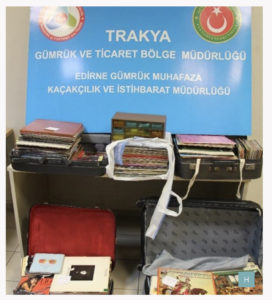
Leonard Cohen, anyone? Largest single seizure of illicit “cultural goods” (LP record albums) in Turkey in 2017. World Customs Organization 2017 Illicit Trade Report, p. 18.
Although the United States strongly supported the global archaeological protections of the 1970 UNESCO Convention, under its US domestic law, the US also reserved its right to exercise independent judgement on the circumstances in which imports would be blocked and objects returned to source countries. The US was also concerned about the possibility that foreign claims could conflict with traditional American principles of private ownership rights.
Even before signing the UNESCO Convention, many countries had claimed government ownership of all cultural property. More did so afterwards. Some foreign national laws covered everything from archaeological finds to photographs, books, coins and postage stamps. Meanwhile, in hearings on the CPIA, the US Congress made it clear that “trinkets” and repetitive objects were intended to be excluded from the Act. The CPIA would only apply to objects of “cultural significance.” The CPIA also limited import restrictions to objects that were subject to current looting in the requesting country. To be covered, objects had to have been actually discovered in the requesting country.[2] When other market nations were trading in similar materials, restrictions had to be part of a “concerted international response” in which other nations had put similar restrictions in place. Restrictions on trade were to be made only if a less burdensome action was not feasible. A final mandatory element of the law stated that the US import restrictions had to “be consistent with the general interest of the international exchange of cultural property…”[3]
How the Cultural Heritage Center at the Department of State directs the Cultural Property Implementation Act.

Senator Daniel Patrick Moynihan, who together with Se, Bob Dole, were the architects of the 1983 Cultural Property Implementation Act, critic of its operation and author of legislation to eliminate its conflict with the N.S.P.A., U.S. Congress photo.

Senator Bob Dole, who worked with Moynihan to pass the CPIA and reform the National Stolen Property Act.
Congress passed the CPIA after almost a decade of negotiation and testimony from stakeholders including archaeologists, academics, museums, art dealers and collectors. In drafting the CPIA, Congress rejected the “blank check” approach UNESCO granted national ownership claims made by foreign governments for art and artifacts, mandating selective import controls rather than across-the-board import bans on objects exported without government permission.
The CPIA called for creation of an 11-member committee representing archaeologists, museums, art dealers, and the public. The Cultural Property Advisory Committee to the President (CPAC) was established to review requests by State Parties signatory to UNESCO for US import restrictions. If the country met statutory criteria for import restrictions, CPAC would recommend terms for a 5-year Memorandum of Understanding (MOU) between the US and the foreign nation. Objects of ‘cultural significance’ at specific risk of looting would be named on a “Designated List” and prohibited from import into the US. Importation of prohibited objects would result in seizure and civil forfeiture of the cultural property, which would then be returned to the country of origin.
For the last two decades, the Cultural Heritage Center at the State Department’s Bureau of Educational and Cultural Affairs has administered the Cultural Property Advisory Committee and effectively redefined the purpose and role of the Cultural Property Implementation Act. At present, the Cultural Heritage Center’s primary strategy is to use overbroad MOUs to limit the free circulation of art and antiques into the US, reinterpreting statutory requirements to suit its purposes and ignoring the fact that these policies aggrandize and give support to dictators and authoritarian rulers for whom “preserving cultural heritage” has become a cover for brutal discrimination against minorities and identity politics founded on xenophobia and prejudice. Astonishingly (or perhaps because ECA’s work is cloaked in diplomatic -speak – or agreements are seen as a useful form of soft-power that serves other State Department interests), there is little pushback from State Department sections that are staunch defenders of human and religious rights and not usually interested in handing political plums to dictators.
The status of the law today.
The way the CPIA is used today could not be farther from Congress’ initial intent – or more divergent from a plain reading of the law. Neither collecting museums nor the art trade are adequately represented (sometimes no one is knowledgeable about the art trade at all) on the Cultural Property Advisory Committee. Designated Lists of restricted objects now include art and artifacts made from 1,200,000 BC to the early 20th century. Trinkets and repetitive objects are blocked along with objects of great artistic and historical importance. Designated Lists include objects as common as arrowheads, clay loom weights, coins minted in the millions, and 19th century furniture and decorative arts. The personal, religious, and community property of Jews, Copts, Armenians, Kurds, and other displaced religious and ethnic minorities are included in agreements with authoritarian Middle Eastern governments. China’s ongoing destruction of Uyghur culture was ignored when its cultural property agreement with the US was renewed in 2019.
For almost 20 years, critics of the operation of CPAC by the Department of State (including a number of former members of CPAC) have argued that the Memoranda of Understanding (MOUs) entered into by the United States have blatantly disregarded the legal requirements of the CPIA.
“Journalists and former members of CPAC have asserted that, not only has the State Department eliminated transparency, but it has also transformed CPAC into an institution engaged in the proactive pursuit of broad import restrictions. Indeed, one reporter has characterized CPAC’s staff as having “pursued a veritable — and intensifying — fatwa against the antiquities trade…[,] successfully hijack[ing] American foreign policy on cultural patrimony” by employing a number of aggressive tactics, such as: selectively controlling the information provided to members of CPAC; employing staff members with an archaeological background, who control CPAC’s mission and even prepare its reports; manipulating the CPAC nomination process; silencing the views of stakeholders (especially dealers); and unevenly applying conflict-of-interest rules. While the State Department is legally permitted to advise the President to reject CPAC’s recommendations, it has no legal authority to prevent CPAC from carrying out its mission in the manner prescribed by Congress.”[4]
That was in 2010 – and today’s policies are even more extreme. Countries seeking new import restrictions provide no public statement of the facts justifying the request. Five-year renewals, which are subject to the same criteria under the law, make no public comment on their compliance with the minimal, “do your best” exhortations of the MOUs – or show how and why renewal is necessary.

Department of State at the Harry S. Truman building, Washington, D.C. Photo Loren, 27 March 2007, public domain.
In no small part, the State Department’s proactive policy to encourage MOUs under all circumstances is due to the work of a dedicated coterie of foreign service officers that built the Cultural Heritage Center at the Bureau of Educational and Cultural Affairs, now a virtually autonomous mini-agency within an agency. Implementing ever-broader import restrictions has been a consistent pattern since 2000, when oversight of the CPAC moved from USIA to the Department of State, and remained under the direction of the same individual, Maria Kouroupas, for 18 years. Kouroupas retired in 2018, but her protégés remain in place.
Currently, twenty-eight countries are subject to comprehensive import restrictions under the CPIA. In theory at least, import restrictions do not apply to objects that have been outside the country of origin for at least ten years, but in practice, US Customs demands significantly more evidence, which is not always available.
Once one of these 5-year restrictions is put in place, it is renewed again and again. (The one exception is the US agreement with Canada, which is not considered a looting hotspot). Some countries have had restrictions in place for more than 30 years. A chain of import restrictions excludes pre-Columbian and colonial art from most of Central and South America. A virtual noose of import restrictions encircles the Mediterranean, preventing entry to the US of ancient and even ethnographic art from almost all the countries on its shores.

Meeting with the People’s Republic of China – Cultural Heritage Delegation on April 23, 2018 at ECA. CC CC0 1.0 Universal Public Domain Dedication.
Currently, there is a notice period of about two weeks between the announcement of a request for an MOU and the deadline for the public to submit comments, and the public does not know what the requesting nation is seeking because the request is not made public. A few weeks after that, a hearing is scheduled via video-conference with the members of CPAC. Twenty years ago, public hearings on a single country could take a full day. Today, a single hour of public comment is allowed for multiple countries’ agreements to be considered. The short lead time and lack of information on the requests seriously hampers the ability of the public to make meaningful comments – or even to become aware of the existence of a pending request.
This article describes three new 2021 Memoranda of Understanding (MOUs) for Turkey, Morocco and Costa Rica, and five renewals, for Colombia, Italy, Egypt, Bolivia and Greece, all of which are effective until 2026.
It also covers four pending requests made in 2021 for new MOUs by Nigeria, Albania, Tunisia, Afghanistan, and pending renewals for Peru and Cyprus. (A notice that Mali and Guatemala are also requesting renewals was issued January 6, 2022.)
Key issues regarding the MOUs are discussed and links to testimony by the nonprofit Committee for Cultural Policy, publisher of Cultural Property News, are included below. We have also compiled a 2022 Chart of CPAC Import Restrictions based on US government sources.
New agreements under the CPIA in 2021.
TURKEY (1,200,000 BCE – 1923 CE)

Hagia Sophia is a World Heritage site dating to c. 537 AD. It was a Christian church for 900 years, then a mosque, then a museum. On 10 July 2020, by order of the Turkish president, Recep Tayyip Erdogan, the building again became a mosque. Photo by Mike McBey. CCA 2.0 Generic license.
A Designated List for Turkey providing descriptions of objects covered by a new MOU was issued June 17, 2021, six months after the MOU was signed by the Trump administration. Instead of blocking imports of objects currently being looted from archaeological sites, the new Turkish MOU prohibits US entry to a laundry list of objects, including not only archaeological objects from 1,200,000 BCE up to the 18th C but also ‘ethnological objects’ up to 1923, such as decorative art, furniture, textiles, carpets and other quite ordinary goods made commercially that have historically circulated globally in legal trade.
The Turkish MOU was a slap in the face to US organizations representing immigrant communities that have strongly argued against any US cultural property agreement with the Turkish government.[5] When Jews, Armenians, Orthodox Christians, and other religious minorities leave the country, they are unable to take their most precious relics with them. Ritual objects, from antique Torah scrolls to tombstones, books, Bibles and religious writings are prohibited export. Furthermore, if persons wish to bring artifacts of Turkish origin from any other country into the US, they risk seizure and return of their property to the Turkish government.
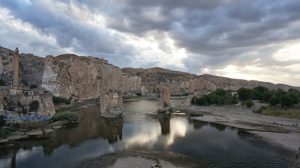
12,000 year old city of Hasakeyf, now inundated by waters of the Ilisu Dam, Ben Bender, CC BY-SA 3.0
Turkey’s poor record on preserving minority heritage is a matter of public record. In 2020, the Erdoğan government converted two major monuments of the Christian faith, Istanbul’s Hagia Sophia and the Chora Church (Kariye Camii), from museums into mosques. Erdoğan’s continued disregard for the protection of minority community monuments directly contradicts the CPIA’s requirement governments take self-help measures to protect its cultural property. Street fighting by Turkish troops recently destroyed two World Heritage Sites at Diyarbakir, the Armenian Catholic Church of Diyarbakir, a 1700-year-old Syriac Orthodox Church of the Virgin Mary and a Jewish synagogue. In 2016, the Armenian Surp Giragos Catholic Church was expropriated by the Turkish government.
CPAC apparently did not agree that Erdoğan’s government failed to protect Turkey’s multi-ethnic cultural heritage, or that the MOU would serve as cover for his ruling party’s identity politics. The CPAC recommended its enactment.
The Government of Turkey did not make public its request – or any evidence supporting its claim for an all-encompassing MOU on objects from 1,200,000 BCE to 1923 CE.
See: Turkish MoU Will Devastate Minorities, Bolster Erdoğan Regime, Cultural Property News, July 11, 2021.
MOROCCO (1,000,000 BCE – 1912 CE)
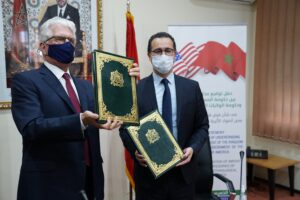
U.S. Ambassador to the Kingdom of Morocco David T. Fischer and Minister of Culture, Othmane Ferdaous signed a new bilateral cultural property agreement on January 14, 2021. U.S. Government photo.
On January 14, 2021, the US and the government of Morocco signed a very broad bilateral agreement restricting antiquities and antiques from importation into the US. Excluded items that can still be imported into the US are “Jewish ceremonial or ritual objects” dating from “the Saadian and Alaouite dynasties ranging in date from approximately A.D. 1549 to 1912.” Other Jewish-owned antique items of stone, ceramic, metal or wood are included in the import ban.
Islamic seal rings of any quality, which non-literate people use throughout the MENA countries to sign documents, are deemed “ceremonial”, and are prohibited together with Muslim “ceremonial” items, a misreading of Islamic practice. The list of “ceremonial” objects also includes lamps and “musical instruments”, which latter are said to be used in Sufi rituals.
The Morocco MOU contains comprehensive restrictions on coins, including Roman Republic and Imperial coins not even listed on Italy’s Designated List. The majority of the coin types listed as Moroccan heritage did not circulate primarily in Morocco and therefore there is little reason for US Customs authorities to think that they were originally found there, as the law requires. Rugs and textiles may still be imported.
The Government of Morocco did not make public its request – or any evidence supporting its request for an all-encompassing MOU on objects from 1,000,000 BCE to 1912 CE.
See: US Renews Italy’s Quarter-Century Art Embargo – New Morocco MOU Blocks Ancient and Ethnographic Art, Cultural Property News, February 1, 2021.
COSTA RICA (12,000 BCE- 1550 CE)
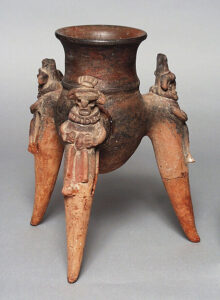
Tripod bowl with a crocodile figure, La Selva Phase, 300-800 AD. Central Caribbean Costa Rica. Author Rodtico21, 31 10-31-13, CCA-SA 3.0 Unported license. LA County Museum.
An agreement between the US and Costa Rica was signed on January 15, 2021.The Costa Rican Designated List of import restrictions covers all known types of ancient materials from the earliest pre-history up to 1550. It includes archaeological materials similar to those of nearby Central American counties: ornaments and beads in jade, gold and other metal, ceramics, stone, bone, resin, and shell objects.
Costa Rica’s Pre-Columbian cultures are not as well-known as those in nearby Guatemala and Mexico. Found objects are generally small, and sculptures and stone carvings are few and smaller in scale, as Costa Rica’s ancient cultures did not build in stone. Costa Rica’s original indigenous populations largely died out after Spanish settlers brought infectious diseases to the region. Fewer than 2% of Costa Rican peoples are considered indigenous, primarily living within reserves located in remote or mountainous areas.
Nonetheless, according to archaeologist researcher David Matsuda, prior to the 2000s, many peasant farmers relied on part time illegal digging to supplement their incomes, dividing village responsibilities so some farmed while others hired out to local professionals who set up illicit digs in the jungle. The peasants referred to archaeological finds as semillas, seeds left for them by their ancestors to feed their families in times of want.[6]
There is little evidence of a US market for Costa Rican antiquities, but historically, there was antiquities collecting by fruit company magnates, members of the Costa Rican government and military, and one major foreign dealer (as well as by the director of the National Museum). CCP and GHA recommended that as an alternative to import restrictions, the government should establish a portable antiquity reporting scheme that would reward peasants for reporting objects found on private land. This would provide objects to museums and educational institutions and allow struggling local farmers to continue to supplement their livelihoods without involving them in criminal enterprises. In addition, US archaeologists should be required to pay their workers a living wage and engage locals to protect archaeological sites.
The MOU did not include these or other public recommendations. It required Costa Rica to use its “best efforts” to protect its cultural patrimony, keep the US informed about unauthorized excavations and thefts, and encourage interchange of archaeological materials. Costa Rica has not heretofore engaged in loans to the U.S.
The Government of Costa Rica did not make public its request – or any evidence supporting its request for an all-encompassing MOU on objects from 12,000 BCE to 1550 CE.
See Costa Rica Seeks US Import Restrictions on Art, by Peter K. Tompa, Cultural Property News, March 20, 2020.
2021 Renewed (and expanded) agreements under the CPIA
COLOMBIA (1500 BCE – 1830 CE)
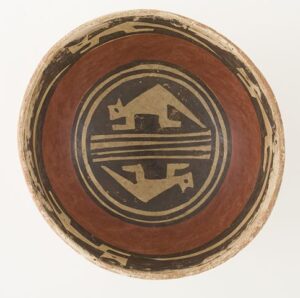
Resist-painted ceramic, Colombia, Colombia, Nariño, Tuza, 1000-1500, Muñoz Kramer Collection, LA County Museum of Art.
MOUs established under the CPIA with Colombia date back to 2006. The renewed agreement that entered into force on March 10, 2021 states that the US will continue to restrict the importation of certain pre-Columbian archaeological material ranging in date from approximately 1500 B.C. to A.D. 1530, “including, but not limited to, objects associated with the Tairona, Sinú, Urabá, Quimbaya, Muisca, Calima, Malagana, Tolima; Tierradentro, Cauca, San Agustín, Tumaco, and Nariño cultures, and ethnological materials, which may include categories of ecclesiastical ethnological material from the Colonial period ranging in date from approximately AD. 1530 to 1830.” The agreement contains standard language about Colombia using its best efforts to protect its cultural patrimony, engage with other countries with a significant import trade, and promote cultural exchange, but does not require that Columbia provide any evidence of actually doing so.
The Colombia Designated List has remained the same since 2006. It covers eight pages of three columns of small type in the Federal Register, ranging from large stone sculptures and rock art to wood, textiles, and leather.
Testimony by GHA and CCP sought to hold the Government of Colombia accountable to reasonable benchmarks that address congressionally mandated self-help measures. It also raised questions about renewing an agreement that had been in place for 15 years for another 5 years without any documentation of current looting or specific findings that Colombia’s cultural patrimony was in danger. Again, suggestions were made regarding establishing a portable antiquities reporting scheme and paying archaeological workers a living wage, but these recommendations were not adopted by CPAC.
The Republic of Colombia did not make public its request for renewal, evidence showing that there was continuing looting threatening all objects listed on the Designated List or showing that it had used its best efforts to protect cultural property and heritage within Colombia.
See: Ancient and Ethnographic Art from Colombia Faces Another 5-Year Ban, by Peter K. Tompa, Cultural Property News, June 29, 2020.
ITALY (9th C BCE – 4th C CE)
Import restrictions on Italian cultural property were renewed on January 19, 2021. The terms have expanded since the first MOU with Italy in 2001 but will remain the same as those imposed in 2011 and 2016. The current Designated List covers Archaeological Material from Italy representing the Preclassical, Classical, and Imperial Roman Periods, ranging in date approximately from the 9th Century BCE to the 4th Century CE.

Display of seized objects from a Belgium collection in Italy. Credit Carabinieri Nucleo Tutela Patrimonio Culturale.
Maintaining the identical restrictions under the Designated List means that a wide range of Roman and pre-Roman sculptures, stone carvings, vessels, manuscripts, mosaics and more will continue to be blocked from entering the US. Vast numbers of antiquities that have circulated for decades in Europe and other regions will be excluded from the US, due to their not having documentation of provenance that meets very recently imposed standards.
Restrictions on coinage, which were first added to the MOU in 2011, cover “struck bronze coins of Roman republican and early imperial colonies and municipia in Italy, Sicily, and Sardinia from the 3rd century B.C. to c. A.D. 37; coins of the Greek cities in the southern Italian peninsula and in Sicily (Magna Graecia), cast or struck in gold, silver, and bronze, from the late 6th century B.C. to c. 200 B.C.” Roman Imperial coins were not included in the List – an addition requested by the archaeological lobby but opposed by US businesses. The Designated List does include gold, silver and bronze Roman and Etruscan coins up to 211 BCE.

Daughter of Niobe shrinking in terror of Artemis. Uffizi Gallery – Sala della Niobe. Florence, Italy.
Photo by Petar Milošević, 26 October 2014, CCA-SA 4.0 International license.
In meeting the CPIA’s self-help requirement, supporters of the renewal pointed to the Carabinieri’s aggressive repatriation of previously exported objects. There are serious concerns that Italian policy has changed focus from domestic crime and neglect to headline-grabbing seizures from foreign collectors. Despite its vast number of monuments and thousands of state-run museums, Italy spends the second-least of all European nations on culture. The Italian government has sold advertising privileges for its cultural property to designers and other commercial enterprises; some of these businesses are funding restoration projects, but also use the sites for self-promotion.
Administration of Italy’s most famous sites and museums has been effectively defunded by Italy’s government: despite massive EU project grants, management is rife with corruption. The AAMD and others have asked for Italy to commit to longer loans and to reduce its extravagant fees in return for renewing MOUs to no avail. A project begun in 2014 called Sleeping Beauty originally directed Italian museum directors to catalog the hundreds of thousands of works of art in museum storage (and in most cases, in storage that does not come close to museum standards for protection of the works). This list only reached 3,900 of the most valuable works and is not publicly available. According to a director of the Cultural Ministry, “the database cannot be consulted for security reasons because making such an inventory public would surely trigger a treasure hunt.” The Sleeping Beauty project has now evolved into a plan to send second and third class objects needing restoration to US museums on three year loans, leavening the mix with a few good objects with only three month loan periods.[7]
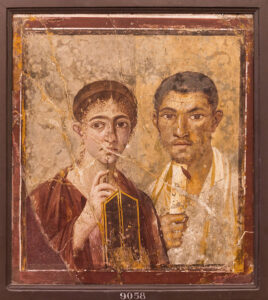
Paquius Proculo, Fresco representing a couple, About 20 CE, Pompeii, Photo Jebulon, 29 July 2015, Naples Archaeological Museum, Naples, Italy, CC0 1.0 Universal Public Domain Dedication.
The Committee for Cultural Policy provided extensive testimony on the renewal of the Italian MOU at the State Department in July 2020. There is no evidence that the U.S. has recently been a marketplace for smuggled Italian art. Nor is there any commitment by the Italian government to make public decades-old information in Carabinieri databases and records to assist US museums, auction houses and dealers to identify looted or stolen objects, despite this information being repeatedly sought by the AAMD.
Without measurable goals and data for review of past agreements – which Italy has failed to provide since 2001 – and without requiring Italy to take steps to demonstrate that it is working in good faith with US cultural institutions, US stakeholders will be left with a permanent blockade and nothing to incentivize meaningful cultural exchange.
Requested additions to the MOU from the public including a ten-year museum loan period were not adopted. Nor did Italy agree to equalize terms for US imports with those in the EU, or to issue export licenses for coins openly available for sale within Italy itself if there was no evidence showing they came from illicit excavation.
The Republic of Italy did not make public its request for renewal, evidence showing that there was continuing looting threatening all objects listed on the Designated List or data showing that its government had used its best efforts to protect cultural property and heritage within Italy.
See: US Renews Italy’s Quarter-Century Art Embargo – New Morocco MOU Blocks Ancient and Ethnographic Art, Cultural Property News, February 1, 2021 and Italy wants 20 Year Art Blockade Expanded to 2025, Cultural Property News, July 28, 2020,
EGYPT (3,000 BCE – 1914 CE)

Register of the Sale Room, Egyptian Museum, Cairo. Università degli Studi di Milano, Eg. Arch. & Lib., Bothmer Collection. Pl 1, Forming Material Egypt: Patrizia Piacentini, “The antiquities path: from the Sale Room of the Egyptian Museum in Cairo, through dealers, to private and public collections.” EDAL IV, 2013/2014.
On November 30, 2021, import restrictions on archaeological material from Egypt were amended and extended for another 5-year period. The Designated List, published December 3, 2021 in the Federal Register, covers Egyptian archaeological material from 300,000 B.C. to A.D. 1750, and includes ethnological material from A.D. 1517 to 1914. The prior import restrictions, dating to December 6, 2016, covered Egypt’s cultural heritage dating from the Predynastic period (5,200 B.C.) through 1517 A.D.
The new Designated List includes every conceivable tool, artifact and household object starting from the Neolithic and going up to the end of the Ottoman period. Items added since the prior 2016 List include so-called ‘ethnographic’ materials up to 1914. In a halfhearted response to outrage in the Jewish American diaspora about Egyptian government claims to the community property of Jews forced out of Egypt, including Torahs and birth and marriage records, “Jewish ceremonial or ritual objects” were explicitly excluded from the 2021 Designated List. Jewish-owned household items remain on it along with everyone else’s. Other religious communities are not spared. The Designated List includes “archaeological” materials such as “Christian, Greek Orthodox, and Coptic Liturgical Objects—Types include censers, crosses, Bible caskets, lamps, patens, Eucharistic goblets, icons, and iconostases”. This list covers materials belonging to Egypt’s religious minorities as well as all forms of Islamic art, together with every conceivable kind of icon, containers used for religious purposes such as Qur’an cases or Greek Orthodox and Coptic Bibles, caskets and ciboria, musical instruments writings and writing tools, architectural elements, doors, panels, windows, furniture, hangings, curtains, shrine covers, prayer rugs (“used in Islamic/Sufi religious ceremonies or rituals” (!), and Greek Orthodox and Coptic shrouds and tapestries. Medieval and Islamic coins have been added that did not appear on the 2016 Designated List.[8]

Pharaohs Golden Parade, April 3, 2021. President Abdel Fatah al-Sissi stands alone on a dais as the Pharaohs are paraded before him on arrival at the new National Museum of Egyptian Civilization. CYC.
One of the key problems with imposing US import restrictions on Egyptian materials is that its previous governments allowed the legal sale of tens of thousands of antiquities until 1983. The export permits issued did not describe objects in any detail, often referring simply to crates or boxes of antiquities. Thus, the vast majority of Egyptian objects in global circulation were exported during a century and a half of first tolerated and then officially permitted export in which even sarcophagi were
sold from a shop in the National Museum itself. Yet none of the objects once freely in circulation, and now distributed worldwide can be correlated to specific permits.[9] Nonetheless, the Egyptian government denies the real history of some 70 years of fully licensed legal export and continues to seek repatriation of all objects, placing US authorities in the position of seizing goods that were lawfully exported simply because their past ownership was insufficiently documented by the government that now claims them.
CCP’s analysis of the Egyptian request documents Egypt’s history of legal export, its neglect of non-Pharaonic monuments and remains, and not least, Egyptian President Sisi’s unimaginably brutal human rights record.
The Arab Republic of Egypt did not make public its request for renewal, evidence showing that there was continuing looting threatening all objects listed on the Designated List or showing that it had used its best efforts to protect cultural property and heritage within Egypt.
See: Egypt’s Brutal Regime Wants to Renew US Blockade on Art; Claims to Protect Heritage & Culture, Cultural Property News, March 10, 2021.
BOLIVIA (2000 BCE – 1900 CE)

Poncho Aymara Indian – Bolivia 17th-18th C.
A CPAC public hearing on a fifth extension of the Bolivia MOU took place in October 2020. Bolivian imports have been illegal to import into the U.S. without an import permit since 2001; it sought an extension of its MOU until 2025. The Designated List for Bolivia appears to cover every form of antiquity and ethnological or colonial art including many objects of clothing and furniture up to 1900. Bolivia does not actually issue export permits for antique cultural objects, meaning that the MOU amounts to a blanket ban on imports. An important factor for consideration in the upcoming renewal hearing for Bolivia was whether there is actual current looting of archaeological sites for objects, or if instead, as is the case in Peru, archaeological destruction now takes place largely through the usurpation of archaeological sites by businesses for construction of buildings and other development projects, to which local governments turn a blind eye.
The Plurinational State of Bolivia did not make public its request for renewal, evidence showing that there was continuing looting threatening all objects listed on the Designated List or showing that it had used its best efforts to protect cultural property and heritage within Bolivia.
GREECE (circa 3000 BCE – 1830)

Cameo with portrait heads, 278–270/69 B.C. Greek, Sardonyx, from Pergamon, Antikensammlung, Kunsthistorisches Museum, Vienna.
While the 2021 renewal of the 2011 and 2016 MOUs with Greece was generally supported by public commenters, including the Committee for Cultural Policy and Global Heritage Alliance, at CPAC’s hearing on October 27, 2020, there were serious concerns that the Cultural Heritage Center’s predilection for increasingly broad, blanket Designated Lists would overcome a commitment made by Greece’s ambassador in the first hearing of Greece’s request for US import restrictions.
Greece’s ambassador stated, “I would like to emphasize that our request concerns the antiquities that have been found exclusively on Greek territory and has no retroactive effect.”[10]
Greek coinage has been collected globally for many hundreds of years. However, archaeological advocates have threatened an expansion of import restrictions on certain ancient Greek coins. Coin collectors, coin businesses and auction houses have argued that expanding Greece’s MOU to include additional Greek coins would create extraordinary burdens for the legal trade and result in the seizure of Greek coins legally exported from the EU. U.S. Customs and Border Protection (“CBP”) has failed to acknowledge that EU member countries are part of a common market that allows for the export of archaeological and ethnological objects with or without a license according to the local law of the exporting EU member.
The restrictions on objects from Greece cover approximately the 3rd millennium B.C. to 15th century A.D., and ecclesiastical ethnological material from Greece from the Early Christian, Byzantine, and post-Byzantine periods, including objects made from A.D. 324 through 1830.
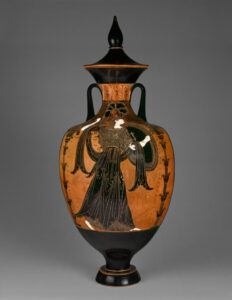
Attributed to the Painter of the Wedding Procession (Greek (Attic), active about 362 B.C.)
Panathenaic Prize Amphora with Lid, 363–362 B.C., Terracotta
89.5 cm (35 1/4 in.), 93.AE.55
The J. Paul Getty Museum, Villa Collection, Malibu, CA.
When Greece’s 2021 Designated List was published, additional coin types had been added, based upon a newly instituted “Primary Circulation Standard” – that a coin supposedly circulated “primarily” in Greece – whatever that means – a hardly provable ‘standard’. This “primary circulation standard” does not exist in the governing statute, the CPIA, and is contrary to the specific, earlier statement by Greece’s Ambassador. The statute as written only allows restrictions on coins first discovered within and subject to Greek export control.
According to Peter K. Tompa of Global Heritage Alliance, the Primary Circulation Standard “has no statutory basis.”
The controversial addition to the MOU reads as follows: “d. Coins from the Byzantine and Medieval Periods —This category includes coin types such as those of the Byzantine and medieval Frankish and Venetian states that circulated primarily in Greece, ranging in date from approximately the 3rd century A.D. to the 15th century A.D.”
The Primary Circulation Standard also raises fair notice questions because the coin types are not specifically defined and the importer is left to guess what the State Department thinks primarily circulated in Greece and what did not. Certain “trade coins” like Athenian tetradrachms, Corinthian staters, and tetradrachms of Alexander the Great and his father Philip circulated widely. Additionally, widely circulating Roman Imperial coins of the Thessaloniki mint also would appear to be exempted, but the importer has no way of knowing that this will be the case once the coins reach Customs.
The Hellenic Republic did not make public its request for renewal, evidence showing that there was continuing looting threatening all objects listed on the Designated List or showing that it had used its best efforts to protect cultural property and heritage within Greece.
CYPRUS (currently circa 7500 BCE-1850 CE)
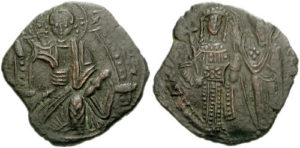
Isaac Comnenus. Usurper in Cyprus, 1185-1191. Æ Tetarteron. Struck circa 1187-91. Classical Numismatic Group, via Wikimedia Commons.
A scheduled hearing of a fifth renewal of an MOU with Cyprus in place since 2002 was scheduled for the same one hour of public comment as Afghanistan and Bolivia on October 5, 2021. It was announced at the CPAC public hearing that consideration of Cyprus would be delayed.
New pending requests for agreements under the CPIA.
NIGERIA

Equestrian figure, symbolizing the king’s male ancestors. Guinea Coast, Nigeria, Yoruba, possibly 18th century, Cleveland Museum of Art.
In late 2020, CPAC heard a request from Nigeria seeking U.S. import restrictions on archaeological and ethnological material representing its cultural patrimony under the Cultural Property Implementation Act. Although a Nigerian official recently announced that an agreement had been made, none has yet been announced in the Federal Register.
Due both to colonial period pillaging and to the 20th-century passion for African art stimulated by modernist art, the vast majority of antique Nigerian art is now in Europe, not in Nigeria, and has been there long enough to permit its legal entry to the US even if an MOU is in place.
Arguments have been made that under the 3rd and 4th Determinations of the CPIA, an alternative path is available to the US. The CPIA cannot be used to remedy Nigeria’s tragic past losses from the colonial period, such as the devastating 19th-century military looting of Benin. Nor can it bring back purchases by collectors in the 20th century, nor remedy the Nigerian government’s neglect of Nigeria’s UNESCO World Heritage sites, the Sukur Cultural Landscape in Adamawa State and Osun Osogbo Sacred Grove in Osun State.
The CPIA’s purpose is not to “shut the barn door after the horse is gone.” The US should work together with Nigerian cultural authorities to support the development of cultural infrastructure, to provide funding for preservation, conservation, museum partnerships, and to encourage archaeological and cultural tourism. US resources would be better spent in expanding cultural relations instead of burdening law enforcement with an unproductive task through an unjustified MOU. The Department of State should instead work diligently to find funding for and assist in the development of cultural and educational institutions within Nigeria.

Gidan Rumfa, Palace of the Emir, Main Gate, Kano, Nigeria, Photo Sani Ahmad Usman, 2013, Wikimedia Commons.
This important task should begin with (1) a collaborative dialog with Nigerian cultural specialists to find out their most urgent needs. Assistance should continue through (2) direct US government financial grants for conservation and preservation of artifacts through the Ambassadors’ Fund and other grantmaking, (3) assistance with repairs to existing museums, (4) financial assistance for education-related projects for children at Nigerian museums, (5) long-term loans of objects from US museums, (6) an information campaign to inform US collectors of opportunities to make gifts to Nigerian institutions, and (7) sponsorship of archaeological work and publication by Nigerian academics and archaeologists through joint US-Nigerian archaeological projects.
The Federal Republic of Nigeria did not make public its request for an MOU.
See: Nigeria: Support Cultural Expansion, Not Art Blockade, Cultural Property News, October 13, 2020.
ALBANIA

Reproduction of a statue of Aphrodite in Seferan, by the Liqeni i Rumbullakët. Photo by Pasztilla aka Attila Terbócs, 13 October 2018, CCA-SA 4.0 International license.
The Albanian request for an MOU failed to show that the U.S. or any other nation is a significant marketplace for recently looted Albanian antiquities. The Public Summary provides no evidence of looting of items from Albania, nor any evidence of a market for archaeological goods in the United States. There is no Customs data showing imports of potentially looted Albanian art.
Our research found that there are no auction records from Sotheby’s or Christie’s, the largest auction houses in the U.S., of any sales of antique or ancient objects from Albania. The only Albanian objects currently in the U.S. market are low value coins, often ancient copies made to imitate the coins from Greece and other regions whose coinage was most widely circulated in ancient times.
Official US government data shows that within the last nineteen years, the vast majority of art imports from Albania consists of original statuary less than 100 years old ($872,635 in 2019, $0 in 2020), paintings and drawings by hand ($115,960 in 2019, $3000 in 2020) and collections of botanical and historic interest ($74,026 in 2019, $425,872 in 2020). Imports of collector’s coins (non-archaeological) amounted to $0 in 2019, $7,048 in 2020, and of coins more than 250 years of age, $14,372 in 2019, $35,486 in 2020.
The entries for 2019 and 2020 for “antiques over 100 years of age” are zero – and there are zero entries for “ethnographic” pieces as described in the CPIA since the more detailed Harmonized Tariff classifications came into force.
The Republic of Albania did not make public its request for an MOU.
See: Albania Wants US Art Embargo But Where is the Art?, Cultural Property News, March 13, 2021.
TUNISIA

Jewish woman and husband, Tunis, c. 1900, Frank and Frances Carpenter Collection, Library of Congress.
Tunisia’s proposal for a new MOU with the US was heard at a meeting of CPAC on January 21, 2020. A decision on the proposal has been delayed for longer than is usual in a request for an MOU. There are substantive reasons why an MOU should be rejected. The rise to power of Zine El Abidine Ben Ali in 1987 marked a change from casual acquisitions of antiquities by foreigners to an organized business run by relatives of the President. Tunisia’s former ruling family was responsible for organized looting in decades prior to the 2011 revolution. Objects were taken directly from museums and archaeological digs. A weak Tunisian law prohibiting illegal excavation was enacted in 1994, but even this was barely enforced. Until 2011, only registered and classified objects with National Heritage Institute (INP) markings were prohibited from trade.
After the 2011 Tunisian revolution, relatives of former president Zine El Abidine Ben Ali fled the country, leaving behind hundreds of antiquities bearing National Heritage Institute identifications in homes and offices. The former director of the National Heritage Institute was sentenced to five years imprisonment in 2012 for dealing in antiquities. The Tunisian press reports that inaction and corruption remain rife today, but the movement of artifacts is reduced to minor items going to other North African and Gulf States. It seems clear that Tunisia should fail the self-help requirement under the CPIA.

Salesman, Tunisia, by Monaam Ben Fredj, 9-17-2017, CCA-SA 4.0 International license.
With respect to the American market, it is noteworthy that every Tunisian artifact sold at Sotheby’s
auction house in the US between 2006 and the present has been an object of Judaica from the late 19th to the early 20th century. Tunisia’s Jewish population was pressured or forced to leave the country. An MOU could block transfer of Jewish artifacts from Europe or Israel to Tunisian Jews living in the U.S. today, or return them to the Tunisian government simply because they lacked sufficient documentation. Restrictions were also requested on Tuareg and Berber ethnographic materials that are not “significant” and are likely to come from nations with much larger Berber populations.
The Republic of Tunisia did not make public its request for an MOU.
See: CCP & GHA Testify on Blockade on All Art from Tunisia: Access to Jewish and Berber Artifacts would be Denied Under Cultural Property Agreement with U.S., Cultural Property News, January 7, 2020.
AFGHANISTAN
The October 5, 2021 public hearing at CPAC of a request for an MOU with “the former government of Afghanistan” was a bizarre example of the Cultural Heritage Center’s determination to push forward MOUs under any circumstances. Barriers to an MOU included the fact that a “former government of Afghanistan” does not exist and cannot be a State Party. Afghanistan’s former government fled the country on August 15 as the Taliban took over Kabul. The Taliban govern Afghanistan, which is the State Party to the Convention. The US has no relations with the Taliban government, but the Taliban are perforce the party to which objects must be returned under an MOU.
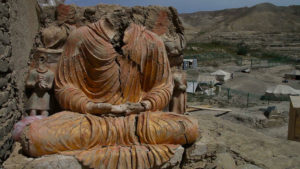
Mes Aynak, Seated Buddha. Photo Brent Huffman, “Saving Mes Aynak.” Archeologists have uncovered countless priceless artefacts at an ancient Buddhist settlement south of Kabul: an ancient copper mine, a series of monasteries, and homes or workshops.
The Taliban government’s cultural head, the Minister of Interior, is a wanted terrorist. The Taliban government has no interest in preserving its ancient cultural heritage or respecting living cultural traditions that are not entirely in line with Taliban policies and social mores – consider the Taliban’s blowing up of the Bamiyan Buddhas and destruction of the figurative objects in the Kabul Museum with sledgehammers.
There is no safe place in Afghanistan to return objects from Afghanistan. Under 19 U.S.C. § 2609, any archaeological material seized and forfeited to the U.S. must be returned to the State Party: in the case of Afghanistan, given to the Taliban. The CPIA does not allow indefinite holds on forfeited items, so seized items could not be kept for some future, more responsible government. Nor does Section 1216 of the 2021 National Defense Authorization Act create a legal basis for safe harbor for seized objects; it applies to objects sent under an agreement with Afghanistan’s government and an Afghan export permit. That should be the end of the story of the request by the former government of Afghanistan, but what the Cultural Heritage Center and CPAC will do remains to be seen.
The “former government of Afghanistan” did not make public its request for an MOU, nor was there any public comment from the Islamic Emirate of Afghanistan, the current government.
See: Afghanistan’s Heritage: A Former Government, the Taliban, and a Questionable Blockade
Cultural Property Advisory Committee Hears Request Under Law that Could Return Art to Taliban, Cultural Property News, October 2, 2021.
What does the future hold?
Actions taken at the State Department’s Cultural Heritage Center support broad national ownership claims by foreign governments, even when the human rights and religious freedom sections of the State Department are highly critical of the same governments for crushing minorities’ cultural rights. Ostensibly in support of archaeological interests, this approach has sometimes backfired, as when Egypt and Turkey have denied access to sites by American and other Western archaeologists, or held archaeological permits hostage for the return of important artworks in Western collections.

Inside the Cathedral of Ani in Ani, Turkey, just a hundred metres from the border of Armenia. Large parts of the roof have fallen down, allowing daylight to find its way into the building. Photo by Bjørn Christian Tørrissen, 9 August 2009, CCA-SA 3.0 Unported license.
For the last twenty years, State Department overseers of CPAC have encouraged foreign states to seek import restrictions for cultural goods into the US, often in defiance of the requirements set by Congress, effectively closing entire areas of the world to US art collectors and museums.
Every request for import restrictions so far made has been approved by CPAC and authorized by the President. Every 5-year bilateral agreement with a State Party (except for a renewal request from Canada in 2001) has been repeatedly renewed. All emergency import restrictions have eventually become permanent MOUs.
The result at the end of 2021 is that the US has a virtual blockade on art from 28 nations, unless the art can be proved to have been outside a source nation for many years. Additional nations’ requests are pending. Some nations’ art has been blocked from import for more than 30 years.
In theory, under the CPIA, importation of an object that can be proved to have been outside of the source country for at least ten years will not encourage looting in that type of object; it may therefore be lawfully imported into the US. However, US Customs (CBP) takes the position that the importer, not Customs, has the burden of showing how long the goods were outside of the source country. The months and years it can take to resolve a forfeiture claim, the repeated requests by US officials for more documentation, and the cost of paying an attorney to deal with a forfeiture mean that most challenged objects are abandoned at Customs, rather than fought for. They are then returned with much ceremony to source country embassies by ICE, as recovered “stolen” objects.
Mark B. Feldman, who was the primary State Department negotiator on both the CPIA and on treaties with Mexico in the 1970s and 1980s, has stated:
“Congress did not intend to authorize comprehensive import controls on all archeological objects exported from a country of origin without its permission. The purpose of the program is not to keep art at home, but to help protect archeological resources from pillage; the findings required by the CCPIA were established for that purpose.
“[Since that time] there have been dramatic changes in U.S. law and practice that have established a very different policy balance than the one the State Department negotiated in the UNESCO Convention and that Congress approved in the implementing legislation.”

Narthex, Chora Church, now converted to mosque, Istanbul, Turkey, photo Giovanni Dall’Orto, 5-26-2006.
Algeria, Belize, Bolivia, Bulgaria, Cambodia, Chile, China, Colombia, Costa Rica, Cyprus, Ecuador, Egypt, El Salvador, Greece, Guatemala, Honduras, Italy, Jordan, Libya, Mali, Morocco, Nicaragua, Peru, Turkey, and Yemen currently have agreements with the US. Iraq (2008) and Syria (2016) are subject to legislative “emergency actions.” (Mexico is covered in another longstanding treaty.)
Tunisia, which applied in 2019, and Albania and Nigeria, which applied in 2021 for the first time, have not yet signed MOUs. All are expected to be granted: Nigeria’s Minister of Information and Culture, Alhaji Lai Mohammed announced to the press in August that an agreement was ready to be signed soon.
A new request from the “former Government of Afghanistan” was heard by CPAC in October 2021. As noted above, the request from a “former government” does not appear to be legally sound – and an agreement would require return of objects to the terrorist government of Afghanistan. Should the MOU be granted to the Taliban, it would not be inconsistent with the overall trajectory of CPAC policy over the last decade. CPAC has demonstrated repeatedly that they are not interested in investigating either the at-home conservation and preservation practices of requesting nations or taking their human rights record into account. That the US government is willing to draw up international agreements of this nature should be troubling, not only to stakeholders in the international art community, but to all those concerned for the integrity of the American government.
[1] Articles 7 and 9 of the 1970 UNESCO Convention read as follows: Article 7. The States Parties to this Convention undertake: (a) To take the necessary measures, consistent with national legislation, to prevent museums and similar institutions within their territories from acquiring cultural property originating in another State Party which has been illegally exported after entry into force of this Convention, in the States concerned. Whenever possible, to inform a State of origin Party to this Convention of an offer of such cultural property illegally removed from that State after the entry into force of this Convention in both States; (b) (i) in domestic law after the entry into force of this Convention for the States concerned, provided that such property is documented as appearing in the inventory of that institution; (ii) at the request of the State Party of origin to take appropriate steps to recover and return any such cultural property imported after the entry into force of this Convention in both States concerned, provided, however, that the requesting State shall pay just compensation to an innocent purchaser or to a person who has valid title to that property. Requests for recovery and return shall be made through diplomatic offices. The requesting Party shall furnish, at its expense, the documentation and other evidence necessary to establish its claim for recovery and return. The Parties shall impose no customs duties or other charges upon cultural property returned pursuant to this Article. All expenses incident to the return and delivery of the cultural property shall be borne by the requesting Party. Article 9. Any State Party to this Convention whose cultural patrimony is in jeopardy from pillage of archaeological or ethnological materials may call upon other States Parties who are affected. The States Parties to this Convention undertake, in these circumstances, to participate in a concerted international effort to determine and to carry out the necessary concrete measures, including the control of exports and imports and international commerce in the specific materials concerned. Pending agreement each State concerned shall take provisional measures to the extent feasible to prevent irremediable injury to the cultural heritage of the requesting State.
[2] So, for example, a Roman object, even if made within Italian territory, that had circulated to the UK and was found there, could not be refused US entry on the basis of an agreement with Italy.
[3] 19 U.S.C. §§ 2601, 2602 (a) (1)
[4] Stephen K. Urice & Andrew L. Adler, Unveiling the Executive Branch’s Extralegal Cultural Property Policy 28–30 (Miami Law Research Paper Series, Working Paper No. 2010-20, Sept. 2010)
[5] See: Elias Gerasoulis: A geo-political perspective on the Turkish MOU, Cultural; Property News, September 30, 2020; also Controversy: How US Recognizes Middle East Government Ownership of Jewish & Minority Heritage: JIMENA’s Sarah Levin Talks About Cultural Property Policies Against Human and Religious Rights, Cultural Property News, December 20, 2019, and 18 Jewish Organizations Protest MENA Nationalization of Heritage to State Department: Letter to Pompeo on Cultural Property Agreements with Syria, Iraq, Egypt and Libya – and Future Agreements with Algeria and 5 Other MENA Nations, Cultural Property News, December 20, 2018.
[6] David Matsuda, Subsistence Diggers, in Who Owns the Past? 255, 263 (Kate Fitz Gibbon ed. Rutgers 2005)
[7] By 2017, ‘Sleeping Beauty’ had devolved into another proposal in which foreign museums would temporarily ‘share’ the lower level of objects in Italian museum storage; “the selection of works preserved in museum warehouses; Works whose beauty might appear “blurred” by their state of conservation. In this perspective, the resources of Italian museums are not only thought for exhibition purposes, but they become a formidable opportunity for research and restoration for scholars and experts.” In other words, an Italian Section of lower quality or damaged material would be placed on 3 year loans with foreign museums which the foreign museum would restore, conserve, and prepare for display, supplemented by a few more high quality works lent for only 3 months. http://musei.beniculturali.it/wp-content/uploads/2017/03/Museitaliani-Sleeping-Beauty-project-brochure.pdf.
[8] The list of coins is lengthy and may be found at pages 87807-87808 in the Federal Register / Vol. 81, No. 234 / Tuesday, December 6, 2016 / Rules and Regulations, https://www.govinfo.gov/content/pkg/FR-2016-12-06/pdf/2016-29191.pdf
[9] Frederik Hagen and Kim Ryholt, The Antiquities Trade in Egypt 1880-1930, The H.O. Lange Papers, Scientia Danica. Series H, Humanistica, 4 · vol. 8, 2016.
[10] Transcript of CPAC Meeting (October 12, 2010) at 17:15-18 (emphasis added). See also IAPN PNG Submission on the Renewal of the Memorandum of Understanding with the Hellenic Republic, https://www.regulations.gov/comment/DOS-2020-0036-0024
 Site of the excavation of Heliopolis, 2015. The German expedition, upon their return after a year, found their excavation partly covered by a garbage dump, requiring them to start each morning by shoveling the trash out of the excavation. In 2016, an illegal concrete construction was found on the spot where they had begun excavating a temple the prior season. Courtesy of the Egyptian Museum Georg Steindorff, University of Leipzig, Germany.
Site of the excavation of Heliopolis, 2015. The German expedition, upon their return after a year, found their excavation partly covered by a garbage dump, requiring them to start each morning by shoveling the trash out of the excavation. In 2016, an illegal concrete construction was found on the spot where they had begun excavating a temple the prior season. Courtesy of the Egyptian Museum Georg Steindorff, University of Leipzig, Germany. 

